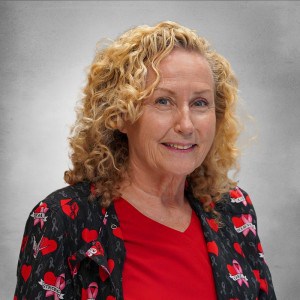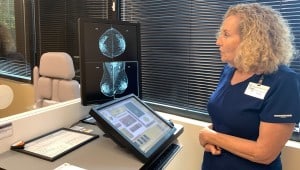Regional One Health’s East Campus Imaging Center offers screening mammograms as walk-ins and by appointment, and there are short wait times and quick turnaround on results.
Our experienced team makes mammography easy and comfortable for patients.
All average-risk women should have an annual screening mammogram starting at age 40. Mammograms are the best way to catch cancer early when it is easier to treat!
If you’re nervous, scared or even just short on time when it comes to getting your mammogram, Regional One Health’s East Campus Imaging Center can help.
Imaging Tech Patty Novak uses experience, knowledge and state-of-the-art technology to offer comfortable testing and accurate images – and to put patients at ease.
“People come in, and they’re scared! They’ve heard horror stories,” Novak said. “I try to make patients comfortable. I treat everyone like they’re my sister, mother, aunt, grandmother.”
She said the mammography experience at the East Campus is quick, easy and comfortable.
When patients arrive, they first check in for their test. Screening mammograms are available by appointment and as walk-ins for women age 40 and up. Appointments are readily available, and wait times for walk-ins are short.
Patients just need the name of the primary care provider who will receive their results, and new patients will need to provide insurance and other basic information. New patients who have had previous mammograms will also be asked to sign a release form to have prior results sent to the East Campus so radiologists can compare their tests.
Once a patient is checked in, Novak takes them to a females-only waiting room equipped with comfortable seating, a bathroom, a TV and changing rooms.

Mammogram Tech Patty Novak tries to put every patient at ease: “People come in, and they’re scared! I try to make patients comfortable. I treat everyone like they’re my sister, mother, aunt, grandmother.”
“We ask patients to undress from the waist up and put on one of the capes we provide,” she said. “We suggest not wearing deodorant, but if you do, we have wipes you can use to remove it, since deodorant makes it look like there’s something in your breast on the imaging.”
As soon as the patient is ready, Novak brings them back for the test.
“It takes about 5 minutes,” she said. “I explain what I’ll do, and then I take several images of each breast – two from a side view, and two from a front view.”
She said technology has improved over the years, making mammograms more comfortable.
During a mammogram, the patient stands or sits in front of the machine and their breast is compressed between two panels. “The new machines keep track of the compression, so it’s much more comfortable. The only thing you feel is pulling on your skin, and it’s very quick – we only leave it in place long enough to take the pictures,” Novak said.
“It is never, ever supposed to hurt!” she added. “If it hurts, let your tech know so they can make adjustments.”
After your test is done, a radiologist reads the results. Regional One Health uses 3-D imaging that leads to fewer false positives and a higher chance of finding cancer early, and every test is read by a breast-specialist radiologist.
If your test is normal, you’ll receive a letter in the mail. If there are concerns, your primary care provider will call you with next steps – typically scheduling diagnostic imaging.
The Imaging Center offers several options.
In a spot compression mammogram, the portion of the breast that contains the area of concern is compressed and photographed.
Magnification view mammography is like a regular mammogram, but the tech uses a specialized screen to get more detail on the area of concern.

Novak said new mammogram technology makes the test more accurate and more comfortable. “The only thing you feel is pulling on your skin, and it’s very quick – we only leave it in place long enough to take the pictures.”
Breast ultrasound involves moving a transducer, or wand, over the skin.
Regional One Health makes sure patients get in quickly for follow-up tests so they don’t have to wait and worry. Also, “For diagnostic mammograms and breast ultrasounds, our radiologists read the results and talk to the patients that same day, right after the test,” Novak said.
Most patients are given the all-clear. Some are asked to come back sooner than a year for their next mammogram, and some end up needing a biopsy.
Along with traditional needle biopsies, Regional One Health provides stereotactic biopsy, where the breast is compressed and a doctor uses a vacuum-assisted needle to withdraw a sample of tissue; and ultrasound core biopsy, where the needle is guided by ultrasound imaging.
Novak stressed most screening mammograms, diagnostic imaging tests, and even biopsies do not lead to a cancer diagnosis. But if you do have cancer, it is the best way to catch it early, when treatment is easier and outcomes are better.
Average-risk women should have an annual screening mammogram starting at age 40, and high-risk patients should talk to their provider about their screening needs.
Novak said helping women take charge of their health is rewarding.
“I feel like I really have a chance to help people – that’s why I love my job!”